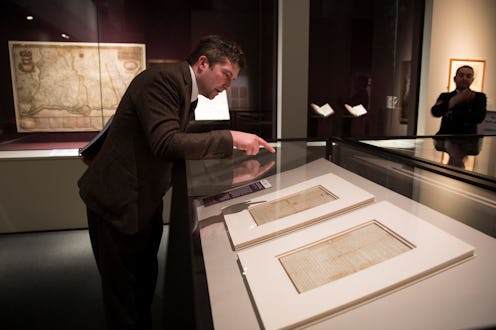
For generations, the Declaration of Independence — aka a piece of paper from which a whole country sprung — has jumpstarted the American imagination. What lurks beneath the parchment? What secrets lie between the calligraphy? So, just in time for Jul. 4, I've put together a list of details about it. Whether the National Treasure franchise is your favorite, or you're just interested in history, here are weird facts about the Declaration of Independence.
Since 1777, the Fourth of July has been celebrated as the official birth day of the United States. Bells are rung, beers are drunk, the smell of barbecue permeates seemingly everything, and the night sky is filled with fireworks. It is a day of over-the-top patriotism, if there ever was one, and it has become synonymous with the American identity.
So why Jul. 4? It was the day Congress adopted the Declaration of Independence, and our founding fathers began efforts to begin the United States. It's also the day that Nicolas Cage's character in National Treasure dreams about all the gosh darn TIME, OK?! That special piece of parchment got inked up, we became the land of red, white and blue, and that's it, that's all.
...Right?
For Starters, The Declaration Of Independence Was Not Signed On July 4, 1776
LOL nope. It was signed on August 2, 1776. Jul. 4 is the day it was adopted by Congress.
And The Fourth of July Isn't Actually Celebrating The Signing
Yep — it's celebrating the adoption of the Declaration of Independence. On Jul. 2, Congress voted to sever ties with Britain, on Jul 4 the adopted the Declaration, and on Aug. 2 they signed the Declaration. To be honest, Jul. 4 seems like the least climactic of those three things, but whatever.
The Original Draft Was, Uh, Lost
The "Fair Copy" has been missing for over 200 years. The mystery! The scandal!
But There Are Still A Handful Of Copies In Existence
Known as the "Dunlap Broadsides," these copies predate the "engrossed" (read: official and nicely handwritten) version of the Declaration of Independence. Following the adoption of the Declaration, Thomas Jefferson, John Adams, Benjamin Franklin, Roger Sherman and Robert R. Livingston set about having copies of the document made and distributed throughout the 13 colonies. Only 26 are still in existence.
As Fans Of The Movie "National Treasure" May Know, There Is Actually Something Written On The Back Of The Original
Seriously! On the back of the Declaration of Independence, a handwritten note reads...
"Original Declaration of Independence dated 4th July 1776."
So, yeah, not that interesting — it was probably used as a label during the 18th and 19th centuries, since the Declaration was frequently rolled up for transportation purposes. But still.
The Declaration Of Independence Spent World War II At Fort Knox
Two weeks after the bombing of Pearl Harbor, both the Constitution and the Declaration of Independence were given an armed escort to Fort Knox in Kentucky, where they stayed for the duration of World War II.
The Average Signer Was Only 45 Years Old
The youngest was Edward Rutledge, a 26-year-old South Carolina lawyer. The oldest? Benjamin Franklin! Benji, 70 years old! You go, Benji! That's like 300 in access to antibiotics years!
One In Eight Signers Had Attended Harvard University
I'm shocked our colors are red, white and blue and not crimson, crimson and crimson.
And Eight Of The 56 Men Who Signed Were, In Fact, Born In Britain
Kind of inconceivable but also very cool that eight of the signers voted for independence from their own country. Gwinnett Button and Robert Morris hailed from England, Francis Lewis was born in Wales, James Wilson and John Witherspoon were Scottish, George Taylor and Matthew Thornton were Irish, and James Smith was from Northern Ireland.
But Ultimately, Because One Signer Recanted, There Are Only 55 Legal Signatures
Richard Stockton, a lawyer from New Jersey, was captured by the British several months after signing the Declaration of Independence and, under extreme duress, recanted his signature. Poor Richard! After securing his freedom, Stockton took a new vow of loyalty for New Jersey.
When News Of The Signed Declaration Reached New York City, It Started A Riot
News of the Declaration reached New York on July 9, 1776. With hundreds of British ships occupying New York's harbor, George Washington read the document aloud in front of city hall, inciting such passion among the first generations of Americans that they began to riot, tore down a statue of George III, and later melted it into more than 42,000 musket balls for the American army.